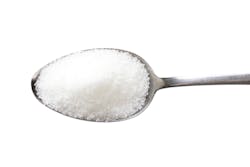Sugar by definition
- The two major natural sugars that are commonly used are sucrose (cane sugar) and fructose (fruit sugar). They are among a group of natural sugars that have related structures with a range of sweetness levels. The ending -ose is applied to the chemical names of carbohydrate sugars.
- Sucrose is a disaccharide molecule (C12H22O11) that contains two simple sugars, glucose and fructose. At least 175 million metric tons are produced from sugar cane and sugar beets worldwide each year.
- Fructose (C6H12O6) is usually less expensive than sucrose and produced from fruits and corn, so it has been substituted for sucrose in many beverages. Some beverage producers are switching back to sucrose.
- Sucrose and fructose are commodities with prices that vary depending on supply and demand as well as national price supports for producers.
Sugar substitutes
- Many types of natural and synthetic sugar substitutes exist.
- Bees produce honey from sucrose because they have an enzyme that hydrolyzes it to glucose and fructose. Its sweetness is about the same as sucrose, it has slightly fewer calories than an equal amount of sucrose and it is non-nutritive.
- Xylitol is natural and synthetic. It is a sugar alcohol (pentane with 5 OH groups attached) but has 40 percent fewer calories than sucrose.
- Saccharin was synthesized in 1879 and became popular during the world wars when sugar supplies were disrupted. It is about 300 to 400 times sweeter than sucrose.
- Cyclamate (cyclohexylaminesulfamate) was commercially available in the 1960s and often used in beverages in combination with saccharin. It was taken off the market in 1970.
- Aspartame is a small protein (dipeptide) consisting of aspartic acid and phenyl alanine. It is about 200 times sweeter than sucrose.
- Acesulfame potassium was approved by the U.S. Food and Drug Administration (FDA) in 1981. Because of its stability, it has many applications in food and beverage products. It is about 200 times sweeter than sucrose and sometimes leaves a slight aftertaste.
- Sucralose was approved in 1998. It is a tri-chlorinated sucrose about 600 times sweeter than sucrose.
Health issues
- Most carbohydrate natural sugars are well metabolized as sources of calories and energy.
- Much interest in sugar substitutes comes from the caloric intake from sugar and desire to reduce calories.
- Most of the sugars and synthetics are non-nutritive, and most synthetics have very few or no calories.
- Most claims that synthetic sweeteners are harmful are unsubstantiated.
- The FDA has reviewed and approved all substitutes.
- Many substitutes are essentially not metabolized, so any hypothetical risk would be negligible.
- Aspartame hydrolyzes to phenylalanine, so people with the genetic condition phenylketonurea should avoid it.
- Honey is generally safe, but it can contain bacterial endospores that can be harmful to infants. Numerous unsubstantiated health claims have been made. It is soothing for a sore throat, and some claim that fructose helps cure hangovers.
Water treatment
- Sugar substitutes are not water contaminants that could cause harm, but some have been detected in water at low concentrations.
- Some substitutes such as sucralose are not digested after consumption, so they are excreted in an unchanged state.
- Sucralose is an example of a substitute that is virtually unchanged during sewage treatment, so when it is discharged into surface waters, it is detectable in some drinking waters at the parts per trillion or parts per billion level.
- Sucralose, a nontoxic chemical, is an indicator of the origin of the drinking water or recycled water. Caffeine is similarly sometimes used as an indicator of source, although it is slowly biodegradable.
Dr. Joe Cotruvo is president of Joseph Cotruvo and Associates, LLC, Water, Environment and Public Health Consultants. He is a former director of the EPA Drinking Water Standards Division.


